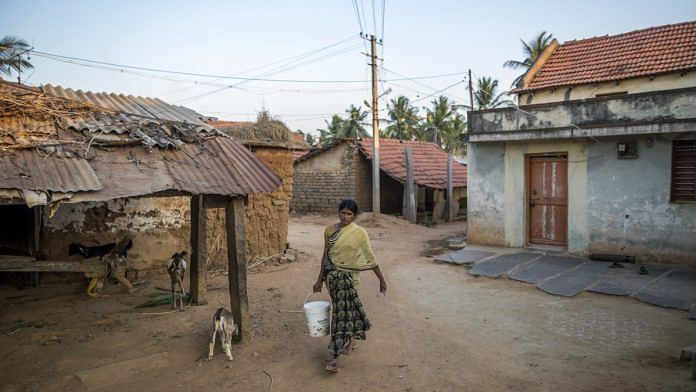New Delhi: Binod Prahiya, a migrant laborer in Mumbai, lost his livelihood when Prime Minister Narendra Modi locked India down in March to contain the coronavirus outbreak. He is now stuck in the city, with no money to support his family back in his home village in India’s eastern state of Jharkhand.
More than 1,000 miles away in Latehar, his wife Shanti Devi doesn’t have enough food to feed her four children. She’s managed so far by working as a farm laborer, but even that work isn’t available now as the harvesting season comes to an end.
“I’m worried we will have to stay hungry,” Shanti Devi, 41, said. Her name doesn’t appear on a list of 800 million people getting free foodgrains from the government during the pandemic. “I have nothing to sell or mortgage — not even jewelery or an animal,” she said.
That’s the story of rural India, where about two-thirds of the nation’s 1.3 billion people live and which accounts for 45% of gross domestic product. Already in distress for many years — following back-to-back droughts and a surprise cash ban in 2016 — the rural economy is now facing its biggest challenge amid a nationwide lockdown of 40 days.
Survival Strategies
Bloomberg Economics’ rural tracker shows output contracted 3.7% in February from a year earlier, the eighth month out of nine that it’s shrunk. Recent high-frequency data points to more pain ahead: Farm equipment companies Escorts Ltd. and Mahindra & Mahindra Ltd. saw a decline of 54% and 27%, respectively, in tractor sales last month, while two-wheeler sales plunged 40%.
“Reports of hunger and vagrancy are coming in,” said Reetika Khera, a professor at the Indian Institute of Management in Ahmedabad. “One survival strategy used by rural residents is to supplement their local earnings with those of members who work in urban areas. That source of income has dried up.”
Consumption is the bedrock of the economy and the rural sector is the biggest driver of that pillar of growth. About 57% of India’s household consumption expenditure comes from rural areas, according to a survey by the People Research on India’s Consumer Economy in New Delhi.
The lockdown came as a shock to migrant laborers and farmers who were getting ready with their harvests, but were forced to destroy the crop in some parts due to disruption in supply chains. To add to the misery is a broken health-care system, which can’t cope up with the tsunami of virus cases.
Rural Unemployment
“On top of this crisis of agricultural supply and demand, rural areas will have a surfeit of migrants who have returned from cities. What are all these people going to do in terms of employment, and even in terms of the basics like food?” said Nikita Sud, an associate professor of development studies at the University of Oxford. “All these cascading crises of income, occupation, nutrition, and health will lead to extreme steps such as suicide.”
Rural unemployment has shot up above 20% in the past 30 days, according to a private survey, and about 400 million workers in the informal economy are at risk of falling deeper into poverty during the crisis, the International Labour Organization said in a report. More than 200 people have died due to exhaustion, starvation, suicide or other lockdown-related reasons such as financial stress in the past month, according to reports in local media.
“The immediate concerns in the rural sector have to do with support to agriculture and livelihood opportunities, even as the urban employment dries up,” said Shashanka Bhide, an adviser at the National Council of Applied Economic Research in New Delhi. “A stimulus is needed even to preserve the goal of food security and livelihoods.”
Government Support
Finance Minister Nirmala Sitharaman last month announced programs to provide free food, fuel and cash transfers for the poor. The government’s support so far of $22.6 billion amounts to less than 1% of India’s GDP, far smaller than the allocations by other countries. The minister is under pressure to unveil more measures to cushion the economy as it heads for its first possible contraction in more than four decades.
In rural areas, the risk of social unrest and hunger is real. There are implementation problems with the government’s food allowance system for the poor, with ration cards being inactive in some cases or being held by money lenders, experts say.
“There are many complaints coming,” said Indira Hirway, professor of economics at the Center For Development Alternatives in Ahmedabad. “Unless the government reorganizes its policies, this may end up in unrest, huge misery and rising poverty.”
There are a few glimmers of hope for farmers though. The monsoon, which waters more than half of the country’s farmland, is forecast to be normal this year, while Modi has recently eased some lockdown restrictions, particularly in rural areas. The central bank last month granted a three-month moratorium on loans, including for farming, and this week provided additional support for short-term crop loans.
The government has said it sees farm output growing faster than expected this year, providing support to an “otherwise sagging economy.”
Back in the rural villages, locals are struggling to cope.
Naushad Ali returned to his home in the Chapra district of Bihar state just before the lockdown began. He had been working at a factory on the outskirts of New Dellhi, where he stitched clothes for exports. Ali got foodgrains under the government program, but not enough to feed his family of seven.
“There’s no work in the village. I’ll have to borrow from moneylenders to survive,” said Ali. “This is the worst phase of my life. The rich won’t suffer, but poor people like me will go deeper into poverty.” – Bloomberg
Also read: India’s farmers can keep economy running in Covid crisis. But who will tell Modi govt that?



